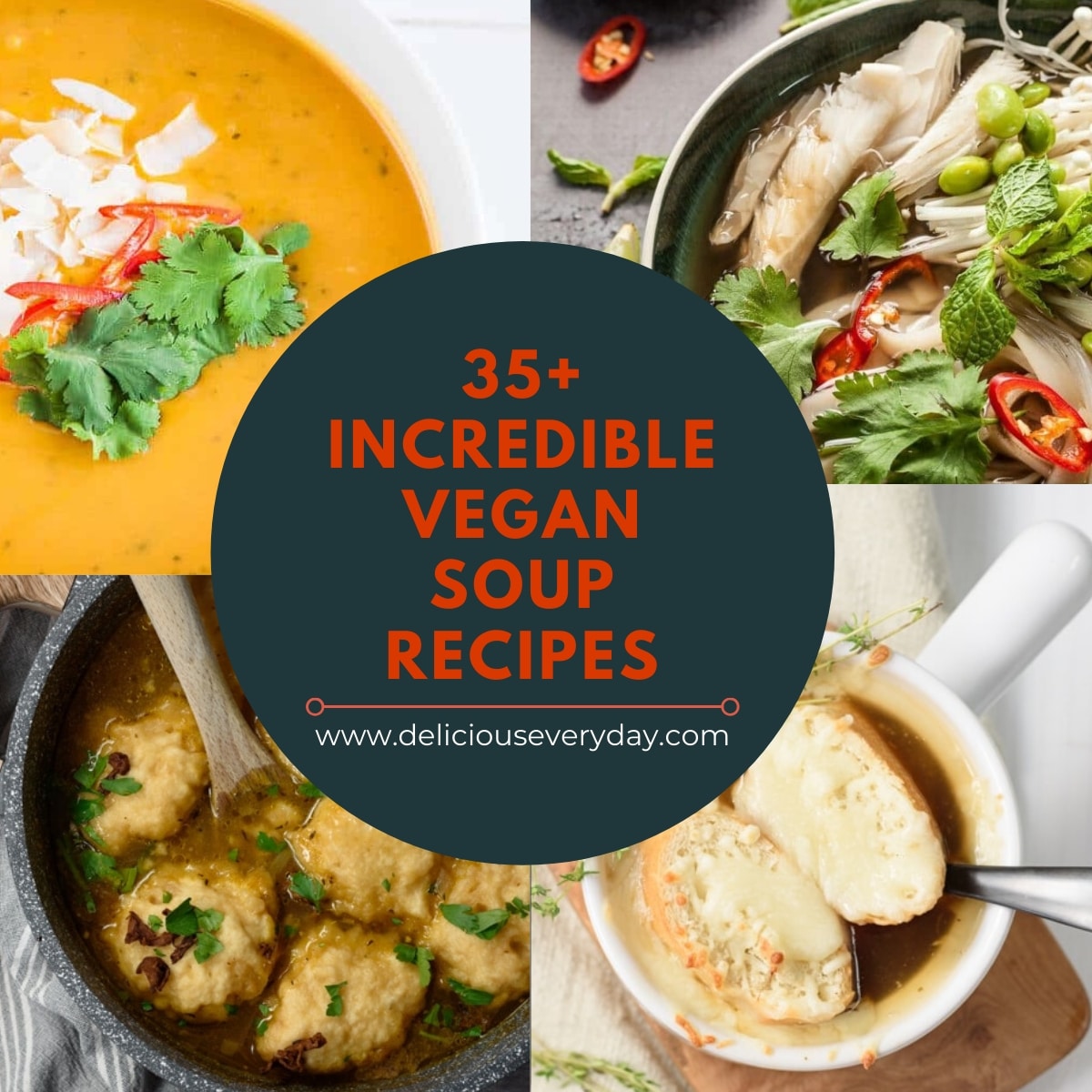Imagine a vibrant bowl brimming with flavor, a comforting warmth spreading through you, all without breaking the bank. This isn’t a dream; it’s the reality of delicious, filling, and incredibly affordable vegan soups. We’ll unlock the secrets to creating hearty, nutritious meals using readily available ingredients, transforming simple pantry staples into culinary masterpieces. Prepare to discover a world of flavor where budget-consciousness meets gastronomic delight, proving that healthy and satisfying vegan eating doesn’t require a fortune.
From creamy tomato soups bursting with sun-ripened sweetness to spicy lentil concoctions that pack a powerful punch, and hearty minestrones overflowing with colorful vegetables, we’ll guide you through a collection of recipes designed to tantalize your taste buds and nourish your body. We’ll explore creative techniques to maximize flavor and nutritional value, offering tips for making large batches economically, preserving leftovers effectively, and serving your creations with flair. Get ready to elevate your vegan culinary game with this comprehensive guide to low-cost, high-reward soup making.
Recipe Ideas for Filling and Delicious Low-Cost Vegan Soups
These three recipes showcase the versatility and deliciousness of budget-friendly vegan soups, highlighting vibrant colors and textures. Each recipe emphasizes maximizing flavor and nutritional value from readily available, inexpensive ingredients.
Creamy Tomato Soup with Roasted Red Peppers
This soup offers a rich, vibrant color and a smooth, creamy texture despite its low cost. Roasting the peppers intensifies their sweetness and adds depth of flavor.
- Ingredients: 1 tbsp olive oil, 2 large red bell peppers, 1 large onion, 2 cloves garlic, 28 oz can crushed tomatoes, 4 cups vegetable broth, 1 tsp dried oregano, ½ tsp dried basil, salt and pepper to taste, optional: 1 tbsp nutritional yeast for extra creaminess.
- Instructions: Preheat oven to 400°F (200°C). Halve and deseed the bell peppers; place cut-side down on a baking sheet. Roast for 30-40 minutes, or until softened and slightly charred. Meanwhile, sauté the chopped onion and garlic in olive oil until softened. Add the roasted peppers (after peeling off the skin), crushed tomatoes, vegetable broth, oregano, and basil. Bring to a simmer and cook for 15 minutes, stirring occasionally. Blend until smooth using an immersion blender or regular blender. Season with salt and pepper to taste. Stir in nutritional yeast (optional) for added creaminess.
Spicy Lentil Soup with Coconut Milk
This hearty soup boasts a warming, spicy kick and a luxuriously creamy texture thanks to the addition of coconut milk. Lentils are an inexpensive and protein-rich base.
- Ingredients: 1 tbsp olive oil, 1 large onion, 2 carrots, 2 celery stalks, 2 cloves garlic, 1 cup red lentils, 4 cups vegetable broth, 1 can (13.5 oz) full-fat coconut milk, 1 tsp ground cumin, ½ tsp turmeric, ¼ tsp cayenne pepper (or more, to taste), salt and pepper to taste, chopped cilantro for garnish.
- Instructions: Sauté the chopped onion, carrots, and celery in olive oil until softened. Add the minced garlic, lentils, vegetable broth, cumin, turmeric, and cayenne pepper. Bring to a boil, then reduce heat and simmer for 25-30 minutes, or until lentils are tender. Stir in the coconut milk and heat through. Season with salt and pepper to taste. Garnish with fresh cilantro before serving.
Hearty Minestrone Soup with Seasonal Vegetables
This vibrant soup is packed with a variety of affordable vegetables, showcasing seasonal produce for maximum flavor and nutrition. It’s a great way to use up leftover vegetables.
- Ingredients: 1 tbsp olive oil, 1 onion, 2 carrots, 2 celery stalks, 1 zucchini, 1 can (15 oz) diced tomatoes, 1 cup green beans, 1 cup small pasta (ditalini or other small shape), 4 cups vegetable broth, 1 tsp dried rosemary, salt and pepper to taste, grated Parmesan cheese (optional, for non-vegan version), fresh basil for garnish.
- Instructions: Sauté the chopped onion, carrots, and celery in olive oil until softened. Add the zucchini, diced tomatoes, green beans, pasta, vegetable broth, and rosemary. Bring to a boil, then reduce heat and simmer for 20-25 minutes, or until pasta is cooked and vegetables are tender. Season with salt and pepper to taste. Garnish with fresh basil. (Optional: Add a sprinkle of grated Parmesan cheese for a non-vegan version.)
Techniques for Maximizing Nutritional Value and Flavor
Using low-cost vegetables effectively involves smart shopping and preparation techniques. Roasting vegetables brings out their natural sweetness and intensifies their flavor. Adding herbs and spices enhances the overall taste profile without increasing the cost. Using vegetable broth instead of water adds depth and umami. Prioritizing seasonal produce ensures peak flavor and lower prices. Proper storage of vegetables extends their shelf life and minimizes waste.
Visually Appealing Soup Presentations
A simple garnish can elevate a bowl of soup from ordinary to extraordinary. A swirl of coconut milk in the spicy lentil soup adds visual appeal and complements the creamy texture. Fresh herbs, such as basil, cilantro, or parsley, add pops of color and freshness. A drizzle of olive oil creates a glossy sheen and adds richness. A sprinkle of toasted nuts or seeds provides texture and visual interest. For the minestrone, a simple garnish of fresh basil leaves adds a touch of elegance. Even a simple bread crouton adds a textural and visual element.
Tips for Making Large Batches of Vegan Soup Economically
Making large batches of vegan soup is a fantastic way to save money and time. By strategically planning your ingredients and employing efficient cooking and storage methods, you can enjoy delicious, nutritious soup throughout the week without breaking the bank. This section will explore practical tips for maximizing your budget and minimizing waste when preparing substantial quantities of vegan soup.
Strategies for Cost-Effective Large-Batch Soup Preparation
Preparing large batches of soup cost-effectively requires careful planning and execution. Five key strategies can significantly reduce your overall expenses while ensuring a delicious and abundant supply of soup.
- Buy in bulk when possible: Purchasing staples like dried beans, lentils, grains, and vegetable broth in bulk from warehouse stores or online retailers often results in significant cost savings per unit. Imagine the difference between buying a single can of diced tomatoes versus a large, family-sized can – the savings quickly add up when you’re making a large pot of soup.
- Utilize seasonal produce: Seasonal vegetables are generally cheaper and tastier than out-of-season options. A hearty winter soup featuring root vegetables like carrots, potatoes, and parsnips will be significantly more affordable than a summer soup relying on expensive imported tomatoes or peppers. Planning your soup around what’s in season ensures both deliciousness and cost-effectiveness.
- Embrace leftovers creatively: Don’t let vegetable scraps go to waste! Vegetable peels and ends can be used to create flavorful vegetable broth, adding depth and richness to your soup without extra cost. Similarly, leftover cooked grains or beans can be easily incorporated into subsequent batches of soup, minimizing food waste and maximizing your ingredients.
- Plan your menu strategically: Choose recipes that use similar ingredients. If you’re making a lentil soup one week, consider making a minestrone soup the following week, using some of the same base ingredients to reduce waste and increase efficiency. This prevents buying multiple individual items for separate soups.
- Proper portioning and freezing: Dividing your soup into individual or family-sized portions before freezing prevents unnecessary thawing and reheating, which can degrade the soup’s quality. Using freezer-safe containers designed for individual servings ensures easy access and minimizes waste.
Frozen Versus Fresh Ingredients in Large-Batch Soup
The choice between frozen and fresh ingredients significantly impacts both the cost and quality of your large-batch soup. While fresh ingredients often offer superior flavor and texture, frozen options provide convenience and cost savings, particularly for out-of-season produce.
Frozen vegetables are generally cheaper than fresh counterparts, especially during times when fresh produce is scarce or expensive. They also offer a longer shelf life, reducing food waste. However, fresh vegetables can impart a more vibrant flavor and a better texture in your soup. The best approach often involves a combination of both: using fresh, seasonal ingredients where possible and supplementing with frozen options for cost savings and convenience. For example, using fresh carrots and celery alongside frozen peas and corn in a vegetable soup can be a great balance.
Methods for Preserving Leftover Soup
Proper preservation is crucial for extending the shelf life of your large-batch soup and preventing spoilage. Different methods offer varying degrees of cost-effectiveness and convenience.
| Method | Cost-Effectiveness |
|---|---|
| Freezing in individual portions | Highly cost-effective; minimizes waste and maintains quality. |
| Refrigeration (short-term storage) | Moderately cost-effective; suitable for up to 3-4 days, but requires larger fridge space. |
| Canning (requires specialized equipment) | Can be cost-effective in the long run if you have the equipment; requires more upfront investment. |
| Vacuum sealing (requires a vacuum sealer) | Cost-effective for long-term storage; requires an initial investment in a vacuum sealer. |
Serving Suggestions and Flavor Variations

Transforming simple, economical vegan soups into satisfying and flavorful meals is easily achieved with a few creative serving suggestions and flavor enhancements. A little ingenuity can elevate even the most basic soup into a culinary delight, maximizing both taste and nutritional value.
Adding texture and protein boosts satiety, making these hearty soups perfect for a complete meal. Flavor customization allows you to tailor your soup to your preferences and the ingredients you have on hand, preventing culinary boredom and ensuring your soups remain exciting and delicious.
Serving Suggestions for Enhanced Vegan Soups
These suggestions demonstrate how simple additions can dramatically improve the overall experience of your low-cost vegan soup.
- Toasted Bread Croutons: Cubed whole-wheat bread, toasted until golden brown and crispy, adds a delightful crunch to creamy soups like lentil or potato soup. Imagine the satisfying contrast of the soft, warm soup against the crisp, slightly browned croutons – a textural masterpiece. For added protein, consider using a whole-wheat bread enriched with seeds or nuts.
- Spiralized Vegetables: Adding vibrant, colorful spiralized zucchini, carrots, or sweet potatoes to a hearty vegetable soup provides both visual appeal and a pleasing textural contrast. The slight sweetness of these vegetables also complements many soup bases, enriching the overall flavor profile. The spiralized vegetables also add additional vitamins and fiber.
- Lentil or Chickpea Salad Topping: A simple salad made from cooked lentils or chickpeas, seasoned with lemon juice, herbs, and a touch of olive oil, offers a substantial protein boost and a refreshing contrast in texture and flavor to richer soups. Picture a vibrant green lentil salad, speckled with herbs, resting atop a creamy tomato soup – a feast for the eyes and the palate.
Flavor Customization Techniques for Vegan Soups
These five methods illustrate how easily you can transform a basic soup into a unique and personalized culinary experience.
- Spice Infusion: A pinch of smoked paprika adds a smoky depth to tomato soup, while a blend of curry powder and turmeric transforms a simple vegetable soup into an aromatic and flavorful delight. Experiment with different spice combinations to discover your own signature blends.
- Herbal Enhancements: Fresh herbs like basil, oregano, thyme, or rosemary can dramatically alter a soup’s flavor profile. A few sprigs of fresh basil added to a minestrone soup create a vibrant, fresh aroma and a subtle peppery note, complementing the existing flavors perfectly.
- Citrus Zest and Juice: A squeeze of lemon or lime juice adds brightness and acidity, cutting through richness and enhancing the overall flavor. Lemon zest, finely grated, adds a fragrant lift and a subtle bitterness that balances sweetness in vegetable soups.
- Roasted Vegetable Depth: Roasting vegetables like onions, carrots, and bell peppers before adding them to the soup intensifies their sweetness and creates a deeper, more complex flavor. The caramelization process during roasting adds a depth of flavor unmatched by simply sautéing or boiling the vegetables.
- Nut Butters and Seeds: A spoonful of peanut butter or tahini added at the end of cooking creates a creamy texture and nutty flavor in many soups. Toasted sunflower or pumpkin seeds add crunch and nutritional value, enhancing both texture and taste.
Simple Vegan Cornbread Recipe
This recipe provides a delicious and inexpensive side to complement your hearty vegan soups.
- Ingredients: 1 cup cornmeal, ½ cup all-purpose flour, ¼ cup sugar, 2 teaspoons baking powder, ½ teaspoon salt, 1 cup plant-based milk, ¼ cup vegetable oil, 1 tablespoon maple syrup.
- Instructions: Preheat your oven to 375°F (190°C). Grease an 8-inch square baking pan.
- In a large bowl, whisk together the cornmeal, flour, sugar, baking powder, and salt.
- In a separate bowl, whisk together the plant-based milk, oil, and maple syrup.
- Pour the wet ingredients into the dry ingredients and stir until just combined. Do not overmix.
- Pour the batter into the prepared pan and bake for 20-25 minutes, or until a toothpick inserted into the center comes out clean.
- Let the cornbread cool slightly before cutting and serving.
Creating delicious and filling vegan soups on a budget is not only achievable but incredibly rewarding. This journey into the world of affordable vegan cuisine has revealed the surprising versatility of simple ingredients and the immense satisfaction of transforming pantry staples into nourishing and flavorful meals. By embracing smart shopping strategies, creative cooking techniques, and resourceful preservation methods, you can consistently enjoy a diverse range of hearty, plant-based soups without compromising on taste or nutrition. So, dive into your kitchen, experiment with flavors, and savor the delicious results of your culinary adventures. The rich, warming aromas and satisfying textures of your homemade vegan soups will be a testament to your resourcefulness and culinary prowess.
Top FAQs
Can I freeze vegan soup?
Yes! Freezing is a great way to preserve large batches. Allow the soup to cool completely before freezing in airtight containers to prevent freezer burn.
How long does vegan soup last in the refrigerator?
Properly stored vegan soup will generally last for 3-5 days in the refrigerator. Always ensure it’s properly chilled and stored in an airtight container.
What are some good substitutes for lentils?
Beans (kidney, black, pinto) or chickpeas can be used as substitutes for lentils, offering similar texture and nutritional benefits. Adjust cooking time as needed.
Can I make these soups without a blender?
Many of these recipes can be made without a blender, depending on your desired texture. Simply chop vegetables finely and simmer until tender.


